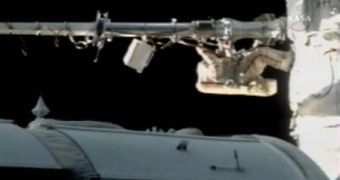This week, two Russian cosmonauts on board the International Space Station (ISS) walked out into space and climbed on the station to install deflector shields, in fact protective panels designed to shield the orbiting station from dangerous space debris and small meteorites.
It took the spacewalkers five and a half hours to complete this mission, and commander Fyodor Yurchikhin and flight engineer Oleg Kotov, the two astronauts that did it, were glad to be back after a tiresome job.
"Hooray! We're back home!" one of the cosmonauts said after climbing back into the space station air lock. The mission was a success and the two astronauts didn't encounter major problems, though one of them complained about an ill-fitted glove on his spacesuit.
For safety reasons, the two men were tethered during the outside mission to keep them from floating away from the ISS, and the mission was overseen by the third astronaut of the station, Sunita Williams, who remained inside.
The space shield was absolutely necessary, as space debris is very dangerous, actually considered the greatest threat to the space station, orbiting about 220 miles (350 kilometers) above Earth, even more dangerous than meteorites.
Space debris are the objects in orbit around Earth created by humans that no longer serve any useful purpose. They consist of everything from entire spent rocket stages and defunct satellites to explosion fragments, paint flakes, dust and slag from solid rocket motors, coolant released by RORSAT nuclear powered satellites, deliberate insertion of small needles and other small particles.
It even includes some rather strange objects, like a glove lost by astronaut Ed White on the first American space-walk, a camera Michael Collins lost near the spacecraft Gemini 10, garbage bags, a wrench and a toothbrush. Sunita Williams of STS-116 also lost a camera during an EVA.
The shield itself is made of 17 protective panels, each about 2 feet by 3 feet (60 by 90 centimeters) and weighing about 20 pounds (9 kilograms). It's not the shield of USS Enterprise, but it's a small step, as another astronaut said.

 14 DAY TRIAL //
14 DAY TRIAL //